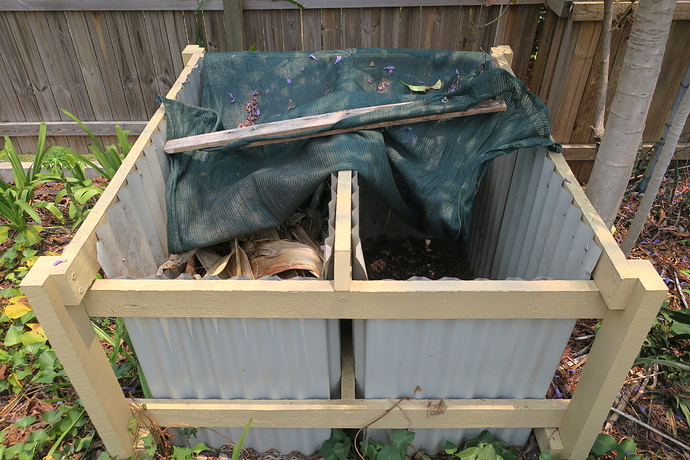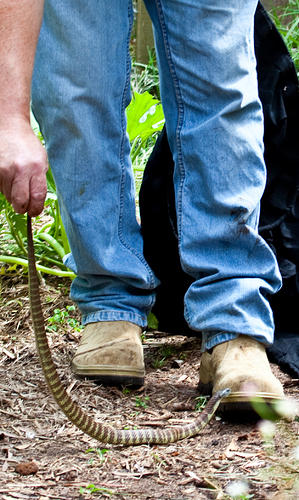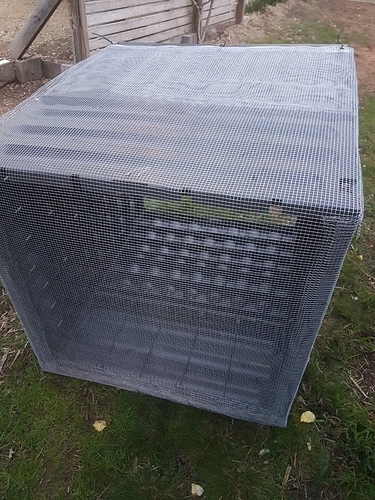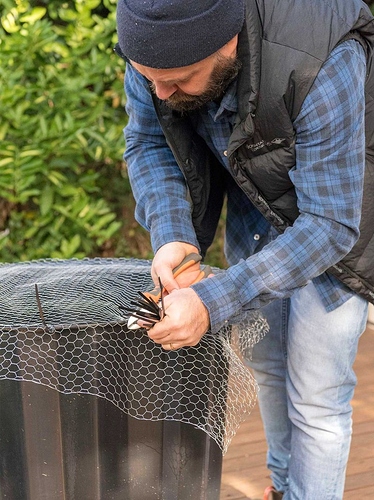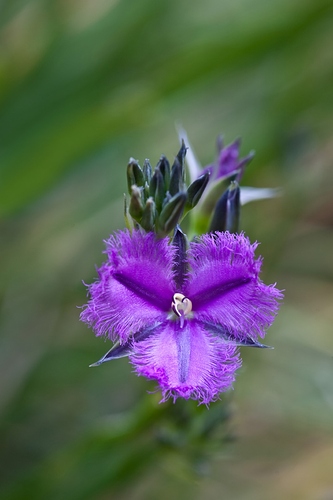Hi All,
Was thinking at home we should try and compost some food scraps and green waste so have had a quick search here and can’t see anything that looks like a guide or tests of the various options.
Hi @Geoff2,
It is very simple to make one’s own compost bin from a wide range of robust containers or materials. It could be an old 44 gallon drum with the top and bottom cut out (plastic ones and better than steel and will last significantly longer), an old rubbish bin (including an damaged wheelie bin with the base cut out) through to using recycled materials such as discarded pallets and/or curving roof sheeting (such as the one we have made).
It needs a cover to keep vermin out and there are two options…
- a impermeable lid to prevent the composting material drying out in dry weather/becoming too wet in rainy weather or
- if the heap is located in a well drained area, a piece of shade cloth may also suffice if one regularly waters the heap to assist with its breakdown.
One can also buy ready made rotating drum type composters through to plastic static bins which sit on a surface with material added through the top.
Usually home composting is the slow degradation of the organic materials rather than the rapid composting seen in commercial operations (where the organic material is subject to reasonably high temperatures through microbial action to accelerate the degradation of the organic material and to also heat sterilise and pathogens such as diseases, pests and weed seed). Significant heat is not usually generated as the volume of the materials been added are low and the overall heap size is small.
ABC Gardening Australia as many articles and videos on home composting, such as this one…
In reality, the materials added to the compost bin/tumbler will have a greater impact on the time taken for compost to form than the vessel holding the materials itself. If you plan to buy one, think about aesthetics, size (based on the amount of materials the house is likely to generate and also how heavy for moving it around), how it is constructed and its materials and also where it will be positioned.
We have made our own compost bins (two side by side) using left over building materials with a capacity of about 500L each. We use two as one side is used for placing materials…when this is semi filled with household and garden organics (after about 6 months), we then start filling the other side. The filled side is allowed to breakdown and removed when needed thereafter. This is what ours looks like:
I would like to support @phb, You don’t need to spend much money on this or to have something fancy.
The simplest situation is don’t have a special bin or tumbler. If you yard is big enough just find a spare corner where you make a pile or two. Unless you put meat, fat etc in it the smell should never be nasty and the vermin it attracts should not be a big deal. Rodents are ubiquitous, you can’t beat them only limit them. Another way to not have a bin is to rotate your beds. Say you have three beds and keep one ‘fallow’. You bury your compostables in the fallow bed every week and grow in the other two. From time to time you rotate them.
In part your decision depends on the volume of material that you will need to deal with, the larger the volume the more thought it will require. This depends on the size of your family and your garden.
Part of this is the choice of fast or slow composting. If you have a large amount to process you may need to go fast to keep the size of the heaps/containers down. This requires designs such as larger volumes with minimal surface area (to keep heat in), taking measures to provide air circulation (ventilation pipes or tumblers) or to monitor moisture levels and mixtures of ingredients more carefully. If you do without all this it will still work - just take longer.
Try your local library for a thin volume along the lines of “All you wanted to know about compost but were afraid to ask” or “The Compost Book” before spending too much cash.
I’ve been chucking our kitchen scraps and other biodegradable stuff into the toilet* for years 
No vermin can get at it then! There is a large population of slaters down there though, but they do a good job of turning it into compost.
*Clivus Multrum
I think this is what @Geoff2 was asking about ie to see which sold ones perform well and those that are less successful. Not everyone has the ability to make one (or I should say make a reasonable one).
Some keen gardeners may not have that much space either. On a small urban block, townhouse etc a tumbler would appeal over all else. We’ve been there several times. And you do need to consider the neighbours if you build an on ground one near the fence?
P.S.
The Australian native roaches never had houses to move into. They quite happily play out survivor naturally in leaf litter around the garden. Apparently they don’t like it when the compost gets too hot, IE fast. We don’t worry too much as the bins we use for scraps are a cut lunch walk from the house. The turkeys seem to be keen to help turn over open piles, unless they have plenty of branches in the pile to slow them down.
For any with a larger plot of dirt, there are all sorts of hidden gems, even one species of blind snake that spends most of it life in the ground raiding termites. It doesn’t bite, but does exude a substance that not even the ants will come near. Fortunately for them they look more like a large worm. And no, they and earth worms don’t become two new ones if they are cut in half!
Thanks for all the info.
The main composting input would be lawn clippings over warmer months and constant supply of carb scraps from 2 persons. I don’t expect to be able to compost all the lawn clippings (I don’t think we could handle all the compost) so could add a bit every mowing or large amounts at longer intervals.
Some further questions;
I’m assuming from the tumbler aspect that agitation is a plus in the process (I guess through aeration) so is it worth mechanically agitating with say a fork?
With respect to temperatures, can it get too hot like black material in full sun, and can it get too cold like dormant in (a Perth) winter?
Yes definitely worth aerating, that speeds the process up considerably, and keeps a healthy aerobic population of bacteria. Anaerobic bacteria tend to stink pretty bad.
Full sun and hot weather under a black cover may get too hot, but keeping it all damp will help. In winter all the microbial activity slows right down, so increasing the temperature of the pile is useful.
The volume will reduce dramatically during the compost process…possibly by up to 90-95% depending on the grass and composting conditions. This means for every 100L of lawn clippings in return one may get as little as 5-10L of finished compost.
One thing to watch with lawn clippings in a compost bin is that green lush clippings can pack down making the compost go sour (poor air penetration causing odours).To overcome this, mix the lawn clippings with a carbon source to keep loose such as dry leaves or finely cut dry prunings from say the vegetable patch. Also turn the compost heap over from time to time to ensure air penetration and to ensure even composting of materials. Turning can be done with a garden fork or spade.
Excess lawn clippings can also be lightly sprinkled as a mulch cover in gardens and vegetable patches. It will naturally break down over a few weeks of normal dry and rain cycles and disappear.
As @gordon indicated, it is not an issue for the compost. The only thing is if you plan to place organic materials in the bin in the middle of the day, the lid might get very hot in summer making it unpleasant to touch/handle.
It is worth noting that in most commercial composting operations temperatures of 80-85°C are achieved (even higher if not managed resulting in spontaneous combustion) so the extra heat from the sun on the compost bin will not be a problem but may reduce composting times. When a compost heap is cold, the time taken for decomposition is significantly longer…so expect compost developing reasonably rapidly in summer and very slowly in winter,
After I finished completeing the request below for the Consumer Action Law Centre, a link was provided for discount composting products which mat be of interest to you.
Even if your local Council is not participating, which ours is not, you can still reecive discounts.
Yes you can aerate with a fork, save on gym fees. Whether it is a plus or not depends. Yes compost can get too hot or too cold. In some cases hot enough to burn although this is unlikely. If too cold it will become dormant but revive when the weather warms up. If it is important to keep it going in cold weather make sure the heap is large (say a cubic metre) and is covered, old carpet works. Normally if it is that cold the plants and grass stop growing and saves you the trouble.
If your lawn is large and you cannot keep up with the clippings there are other options. You can slow down its growth by mowing less often. Yes mowing makes it grow more provided warmth, nutrients and water are there. If you want the explanation google “wire grows grass”.
You can also leave your clippings on the lawn at least sometimes, this will help improve soil carbon which adds to nutrients and water holding. You can also slow down your lawn by feeding and watering it less. Overall a neat, well manicured, lush green lawn is a very resource intensive beasty.
For the past 28 years in Canberra I’ve had two compost heaps side by side in a basic wooden fence/frame at the back of my garden. I don’t turn them, cover them, aerate them, water them or do anything except heap one up with grass clippings, weeds, prunings, food scraps (no meat), and leave the other to compost. When the one I’m using gets too high (about 1.5m) I leave it alone and start piling everything on the other heap. By the time that gets to 1.5m the other one has composted down low and I start piling everything on that one. Whenever I need some compost (which is hardly ever) I dig it out from under the ‘dormant’ heap. The compost smells wonderfully rich and almost sweet, and the cherry tree growing next to it produces a ton of cherries every year.
I’ve tried all types and unless you have a large garden with year round supply of material the heap becomes a pile of vermin ridden rubbish. The rotating bins don’t work. You are better off sticking it all in your council green waste and buying their compost back. The cost of adding nutrients and material to generate a healthy compost on a small scale is not worth the rubbish you end up with. I lived on a farm and it was a chore to collect manure, greens ets and mix them up keeping temperature and moisture at the correct levels. I would never bother again. Sorry to rain on your idea.
Our local Council does not provide compost but only sells mulch which contains treated pine and other contamination.
The output of the adjacent Bedminster composting plant is sold to cane farmers complete with heavy metal contamination.
When my mate in Gladstone was working at the shale oil plant, a helicopter was used to collect air samples high above the plant.
My mate asked the crew what the air quality was like and was told is was fine.
The person then added "If you want to see heavy metal pollution, then go and have a look at the cane farms around Tully.
The contamination was due to the Bedminster compost being used on the farms.
I would not use either the Council mulch or the Bedminister compost if they offered to pay me.
My experience is exactly the reverse. My system is only a moderate size, the scraps from two people and the trimming from a medium sized garden that is mainly trees that contribute little, grass clippings are not included. I give my heaps (two) very little attention, spend nothing on it, I don’t add anything special, the vermin are not a problem and I don’t buy in compost. I find the idea of exporting my green waste and losing the nutrients in it (which then have to be replaced) peculiar. Compostables are a resource not a liability. You don’t need to overthink this, keep it simple.
That is correct and composting for an agricultural input is very different to a home compost bin.
In agriculture, the compost which is produced has two benefits, the organic carbon which can improve the physical characteristics of the soil and nutrients, to reduce fertiliser use and assist in supporting plant growth. To achieve both good organic carbon and nutrients, the ingredients of the compost are appriproately selected, the mixing and composting processes is managed to minimise composting times and nutrient losses.
In the domestic situation, the primary aim is for organic carbon and compost ingredients are highly variable and those available from household/residential activities. Usually the compost is uncontrolled, takes considerably longer and the output is low in nutrients.
Home composting also reduces the amount of organic materials going to landfill, which invariably turn into methane in anaerobic environments and thus increases eCO2 in the short term. It also improved the physical characteristics of a soil (water and nutrient holding capacity, buffering capacity, permeability/infiltration, soil structure etc) when used in the home garden.
I highly recommend having a home composting system. It is an excellent resource for recycling green waste on-site. At my place, progressively applying compost to the veggie patch has transformed the soil from dry and barren to rich, friable and productive - with lots of worms. I also use compost elsewhere in the garden and fruit trees, ornamentals and native plants thrive on it.
I’ve tried several types of compost bin. The first was a solid plastic bin with an open base and tight-fitting lid. Because it was on the ground, it produced beautiful compost and attracted many worms. However, I found it difficult to remove composted material from the base, rodents somehow got in from underneath and the bin capacity was insufficient for my needs.
Due to the rodent issue, I then opted for two tumbler bins. There was no rodent problem but I found the tumblers to be very clunky over time. They took much longer to produce compost and were unstable with a heavy load. I also found it difficult to remove the composted material from these bins.
I then purchased a 600L cubic plastic flat-pack compost bin. In September 2017, it cost $149. I also purchased a “rodent-proof” base (which was produced by the same manufacturer for that compost bin) for an additional $39.80. The snap-in-type joins holding the sides of the bin together were not sufficiently stable once the bin started filling, creating small gaps at the seams. Also, the base was not square but had cut-outs on the four corners, which were large enough for a rodent to get through. Last summer, a tiger snake found its way into the bin, presumably attracted by rodents. The snake was extracted and relocated by a reptile removalist.
I emptied and cleaned the compost bin, affixed galvanised snake-and-rodent mesh to the base and all four sides and made a long flap from the mesh so I can still access the bin’s base-flap in order to remove compost. I also affixed stainless steel angle-brackets to stabilise the bin due to the flimsy design of the interlocking plastic tabs which held the sides together and stainless-steel hinges to the lid to reinforce the plastic hinge.
The system has been working very well. Worms can still make their way into the bin through the mesh base, the bin has excellent capacity and is quick to turn clippings and scraps into compost.
One problem: a rodent was in there yesterday! The only way it could have gotten in is by squeezing under the lid - which sits as a hinged flap on top and doesn’t securely lock onto the bin.
I am not giving up on that compost bin! I’ll find a way to secure the lid (perhaps simply placing a brick on it will suffice) or otherwise dissuading the rodent. Possibly adding some offensive-smelling organic matter such as a store-bought fertiliser will work.
I saw this example online of chicken wire being used on the base of a solid-sided bin with a tight-fitting lid. This would work:
Good luck with your composting venture. My garden - including the native plantlife - is loving the bounty from my compost bin.
Lovely pics @margotk, including the little tiger.
I dug our plain open bottom bins into the ground approx 10cm. With two in use once every six months I tip one on it’s side to remove and store the product, while a little goes back in to help restart.
Hi,
I have a suburban block, and composte kitchen and garden waste quite easily. No way am I paying the council for a separate bin for garden waste!
I live on the Sunshine Coast, so hot summers and mild winters.
I’ve found that:
Above ground worm farms don’t work well as they get too hot.
Rotating drums need too much attention and often fill too much for their supports, with the composting time still too slow. I would need 3 on the go…I’ve turned mine on its side to use as a standard bin.
Any container needs a decently fitting lid - I mark the top with paint for easy opening.
Sink the lower 3-5cm into the ground so worms, insects, etc can come/go as they please.
Add a few cm of garden soil to the bottom to start off a new bin, to bring in the needed insects and microorganisms.
Easy mixing of the contents with a compost lifter (like a big corkscrew).
Cover the upper surface with newspaper - local free ones are perfect.
I don’t add diary or animal products to the compost bins (I have 2), so the smell is quite nice, no rodents.
Placement is important - not too far from the kitchen or you’ll not use it.
Generally I stick to the ratio of 3 times as much low nitrogen stuff (“browns”) as high nitrogen (“greens”). But this is across the week, as different stuff goes in on different days.
It’s not too complex, really.
Good luck
The question still remains are there any commercially available home composting solutions worth buying? Some say tumblers work, others say not. Same for bin types and the issues some have with those.
Are there tumblers worth purchasing and others to avoid. Do some of the bin solutions work and others not (some it seems need rectification to be what they say they are)?
